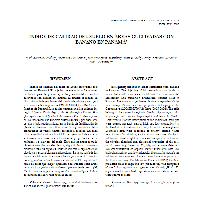Resumen
-
The objective of this research was to obtain an index that could serve as a useful tool for environmental assessment and managing agricultural banana soils in Panama. The work was performed in five independent farms from Alanje District and six properties belonging to the Cooperative COOSEMUPAR in Baru (2005-2006). The soils belong to the orders Inceptisols (Andic Dystrudepts, Udic haplustepts and Dystric haplustepts) and Entisols (Andic Udifluvents). For the description of the indicators, four pits were opened for each area of high and low productivity in the band of fertilization of recently flowered banana plants. Biometric data were recorded of twenty banana plants near harvest. In addition, each site was measured for basic infiltration, total weight of roots and sampled to determine the physico-chemical and biological properties of the soil. In all farms high levels of Ca, Mg and K were detected, low concentrations of organic matter associated with low biological activity and low microbial biomass. In most farms infiltration was slow and degraded structures were present in the lower horizons. The Minimum Data Set (MDS) that best predicted areas of high and low productivity was composed of the following indicators: percentage of sand, pH, Ca, K, organic matter, microbial respiration, mineralization rate and total weight of roots.
